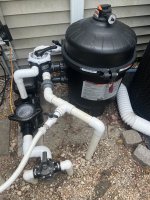Hi All.
Just got my first VS pump (Hayward MaxFlow 500 VS 1.65). I also have an Acquacal T115 heat pump and tied the vs pump and heater into the Acquacal
Poolsync (really liking it so far). I know many recommend the necessity of adding a flow meter to properly optimize flow(Gpm)/rpm/turnover.
Before I install a $150 flow meter, is it possible to extrapolate out flow/rpm based upon my heat pump turning on at a minimum rpm?
What I found on my pool is that an rpm of 1900 activates the heat pump (fan & compressor) which requires a minimum Flow rate of 30gpm.
If I raise the rpm to 1.5x1900 (2850rpm) can I assume my gpm would be ~45 at 2850, or it doesn't work that way?
Thanks for your opinions!
-AP
Just got my first VS pump (Hayward MaxFlow 500 VS 1.65). I also have an Acquacal T115 heat pump and tied the vs pump and heater into the Acquacal
Poolsync (really liking it so far). I know many recommend the necessity of adding a flow meter to properly optimize flow(Gpm)/rpm/turnover.
Before I install a $150 flow meter, is it possible to extrapolate out flow/rpm based upon my heat pump turning on at a minimum rpm?
What I found on my pool is that an rpm of 1900 activates the heat pump (fan & compressor) which requires a minimum Flow rate of 30gpm.
If I raise the rpm to 1.5x1900 (2850rpm) can I assume my gpm would be ~45 at 2850, or it doesn't work that way?
Thanks for your opinions!
-AP



